
 |
|||||
|
|
|||||
|
|
|
|||||
|
|
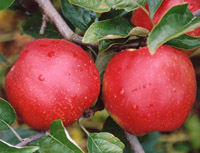 |
RED CLAYGATE Sometimes called Claygate Red. A bud sport of Claygate Pearmain that occurred on a tree at Allgrove’s Nursery, Middle Green, Buckinghamshire some years ago. Apples and scionwood were brought to us by Nick Houston, who researched the remaining orchards (now gone) following the death of the last Mr Allgrove. The apples are a little earlier to mature than Claygate Pearmain, being fully ripe straight from the tree. It is also redder than Claygate Pearmain, but otherwise can be considered the same. Dessert and cider, Oct to February, crisp, juicy and richly flavoured. T* Pollination Group 4 |
||
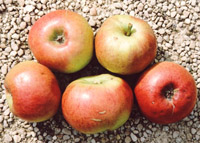 |
RED CLUSTER An old cider apple once grown in Devon and Somerset. Veitch’s Nursery of Exeter claimed it to be a Devon variety, though Hogg attributes it to Somerset. It was recorded in 1884, though its true age is unknown. In modern times, having fallen out of cultivation in Britain, it was assumed extinct but was found by us to be listed at the Grove Research Station, Tasmania and new grafts were taken in 2005. The old literature suggests the apples are small but the fruit on our new trees have been medium sized and sometimes large. In different years and on mature trees its tendency to form many spurs would produce a large volume of smaller apples. The apples are very closely clustered and colour up bright red quite early in the summer. The flesh is sweet and without much acidity. A perfectly pleasant dessert apple, with sweet crisp and juicy flesh – and not unpleasantly tannic, but clearly of cider quality. Trees spur freely and fruit abundantly when young. Pollination Group 6 |
|||
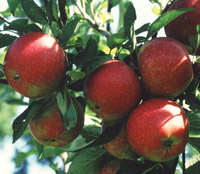 |
RED
ELLISON A sport of Ellison’s Orange (see separate entry
above) with a very red flush. It was found at H.C. Selby's orchard at
Walpole St Peter, near Wisbech, in Cambridgeshire, in 1948. A showy dessert
apple, best eaten within a month. Pollination Group 4 |
|||
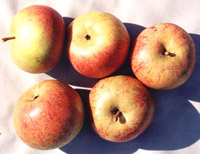 |
RED
INGESTRE An important re-discovery of a famous lost apple. Red
Ingestre was raised by Thomas Andrew Knight of Wormsley Grange, Herefordshire,
around 1800, along with Yellow Ingestre (two pips from the same apple)
from the Golden Pippin crossed with the Orange Pippin. They were named
after the estate of Lord Talbot at Ingestre in Staffordshire. Hogg knew
it in 1884, but Bunyard in 1920 reported it ‘now rarely met with’
and it has not been officially sighted since. A few years ago, Mick Miller
of York acquired a Yellow Ingestre sapling from the Northern Fruit Group
but when it fruited the apples were redder and slightly later to ripen
than Yellow Ingestre. After investigation he discovered that the source
tree, now very old and in Clumber Park, Nottinghamshire, was merely labelled
‘Ingestrie’. The fruit closely matches descriptions of Red
Ingestre, with small rich yellow apples, flushed orange/red with some
stripes, and with russet dots. The flesh is crisp, juicy and rich, ripe
in October and storing for a while. Both Hogg and Scott considered it
a first rate dessert apple. The tree is a regular and good cropper, reputedly
disease free, though of modest growth – lax, according to Scott.
We are grateful to Mick Miller for his investigation, rediscovering this
lost apple, and enabling us to send it back out to the world, anew. Red
and Yellow Ingestrie have long been incorrectly spelt. We are grateful
to Martin Gadsbey of Stafford for pointing out that the original and proper
spelling of ‘Ingestrie’ was ‘Ingestre’, pronounced
in the same way. Pollination Group 4 |
|||
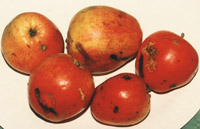 |
RED
JERSEY A cider ‘bittersweet’ apple that dates from
before Evelyn’s Sylva, second edition, of 1669. It probably originated
at West Pennard near Shepton Mallet in Somerset though old trees were
also found in Devon. A middle season, late flowering apple, ripe in October.
The fruit is small, conic, green-yellow, flushed dull and bright red and
russeted in the stem cavity. The flesh is white, juicy, crisp, sweet and
astringent. It ferments slowly, making a good quality cider, though it
is quite tannic and thus it is usually blended. Large spreading trees
with a thick crown. Regular and full crops.Very late into leaf. Pollination
Group 5 |
|||
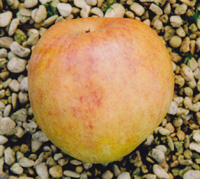 |
RED
RUSSET An American apple, originating in 1840 on a farm at Aston
Sanborn, Hampton Falls, New Hampshire, and introduced by Cole in 1849.
It was in England before 1872, when John Scott included it in his ‘The
Orchardist’. It was last noted in 1905 in Britain or elsewhere.
We noticed it in the collection of the late Nick Botner in Oregon and
he sent scions in 2008. Having fruited in 2011, we are certain that it
is indeed the ‘lost’ Red Russet, so fully described by Scott.
He said, it was a large, top quality fruit, round and conical with skin
of yellow, shaded with dull red and deep carmine in the sun, thickly covered
with grey dots, with a slight appearance of rough russet over most of
the surface. The stalk is short and thick inserted in a medium cavity
surrounded with thin russet. The eye is nearly closed and set in a narrow
uneven basin. The flesh is yellow, solid, crisp and tender with an excellent,
rich, subacid flavour. The tree is productive. Ripe in late October, we
have found it best if kept a short while, and Scott said it was in season
from January to April. The flesh is very sweet, rich, complex and fragrant,
with a hint of pineapple, banana and pear. The apples themselves are very
attractive. Pollination Group 4 |
|||
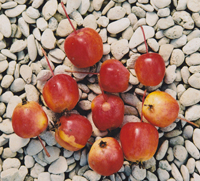 |
RED
SIBERIAN An old apple, probably going back to antiquity and also
known as Red Siberian Crab. Along with the Yellow Siberian Crab and others,
it was favoured in the late 18th century by Thomas Andrew Knight and other
pioneers of the emerging cider industry as a breeding parent for cider
apples. The apple is presumed to have come from Siberia and is therefore
extremely hardy. The Red Siberian has not been encountered in Britain
for many years and we noticed it in the list of a private fruit collector
in America, the late Nick Botner. He sent us many scions of the apples
he held and which have been ‘lost’ over here. This is a small,
very sweet and slightly tannic apple, the shape of which is very distinctive.
The apples are little more than an inch in either direction. The eye is
crowned with long waving sepals and has a ring of knobby protuberances.
The skin is waxy and rich amber/red. The apples hang like cherries in
clusters, from long stalks. Mid season. It should be popular amongst cider
enthusiasts. Pollination Group 3 |
|||
 |
RED
TWO YEAR OLD Collected from Minsterworth in 1993 by Charles Martell
and added to the collection of the Gloucestershire Orchard Group. A triple
purpose apple, which is medium sized, round with a green skin, flushed
dark red. Ready to pick in late October, but it needs storing until December,
when it is sweet enough to eat raw, and can also be cooked, when it keeps
its shape and is rich, fruity and tangy. The name, as with others called
‘Deux Ans’, meant that the apple would last until the first
apples were ripe the following year, but this is unlikely in the present
warmer climate. Pollination Group 4 |
|||
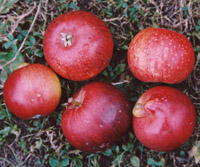 |
REDSTART
An Oxfordshire apple that arose around 1950 in an Oxford garden. An early
season dessert apple, ripening in late August or early September. The
flesh is crisp, very juicy, sweet, with mild tangy acid, refreshing and
with a good flavour. A good and colourful early apple lasting a few weeks.
The apples are streaked with crimson, merging to darker red areas, almost
covering the apple. Pale, starry dots appear on some fruit. A good early
apple. Pollination Group 4 |
|||
|
||||